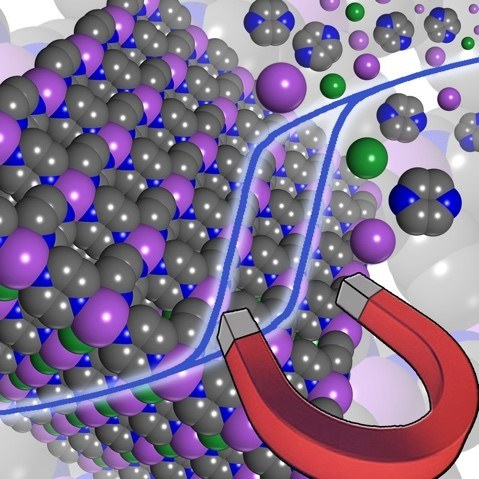Nov 9 2020
Led by the Centre de Recherche Paul Pascal (UMR 5031, CNRS-University of Bordeaux), an international team of scientists has found a unique way to design magnets with exceptional physical properties.
 Pictorial representation of the molecule-based magnet and its magnetic properties. Image Credit: Rodolphe Clérac.
Pictorial representation of the molecule-based magnet and its magnetic properties. Image Credit: Rodolphe Clérac.
The process could make the magnets complementary to or even compete against traditional inorganic magnets, which are extensively used in day-to-day appliances.
Magnets are an essential part of day-to-day life and can be found in a number of electronic and medical devices, such as electric motors, household appliances, and computers. The need for new magnetic materials has considerably increased in the last few years. Many such materials are made up of rare earth metals or metallic elements that can be used at ambient temperature.
The worldwide market for these inorganic magnets was worth US$ 19.5 billion in 2019 and projected to touch US$ 27.5 billion by 2025 (www.imarcgroup.com). But inorganic magnets can be costly to make and access to their constituent elements is mostly limited.
For several years, chemists have been attempting to create high-performance magnets at low cost and energy using molecular units of abundant metal ions and low-cost organic ligands. Thus far, very few molecule-based magnets working at room temperature have been described, and the few recognized examples cannot store data.
New Magnets have Possible Real-World Applications
An international group of scientists led by CNRS scientist Rodolphe Clérac at the University of Bordeaux has discovered a new chemical approach to design magnets-based coordination networks made up of an organic radical (a molecule having an unpaired electron and carrying spin) and a paramagnetic (spin-carrying) metal ion to produce a highly robust magnetic interaction.
These new magnets possess a number of preferred physical properties, including high operating temperatures (up to 242 °C), low density, and large coercivity (i.e., the ability to store information).
The new lightweight magnets with densities of about 1.2 g cm–3 vs. over 5 g cm–3 for traditional inorganic magnets display large room temperature coercivity up to 7500 Oe (two orders of magnitude higher than formerly reported for molecule-based systems) and high operating temperatures that surpass the present record for coordination networks by over 100 °C.
Besides the extraordinary physical properties, the process of synthesizing these magnets is comparatively direct and may be effortlessly applied to a number of metal-organic materials for conversion to metal-organic magnets.
Regardless of the relative ease of fabricating the new magnets, they are highly air-sensitive and poorly crystalline, yet the scientists were able to control these problems to completely characterize these magnets. The magnets’ magnetic and electronic properties were characterized in an element-selective manner via international collaboration.
While the BM01 and ID12 beamlines at the European Synchrotron Research Facility (ESRF) were crucial to comprehending these materials with regards to their magnetic properties and structure, recent Academy of Finland research fellow Aaron Mailman contributed to the spectroscopic and analytical characterization of these magnets.
The synthetic strategy used in this work should be widely applicable to related systems and while these results represent new benchmarks for coercivity and critical temperature, in low density, lightweight metal-organic magnets, I expect future results will lead to further improvements and real-world technology applications.
Aaron Mailman, Research Fellow, Academy of Finland
Clérac concluded saying, “To be honest, I hadn’t considered applications of my research before this work, as my team and I do fundamental science, but it is now clear to me that we can potentially use these materials in magnetoelectronic, magnetic sensors and recording technologies, especially when the weight is an issue, for example, in smartphones or satellites.”
Journal Reference:
Perlepe, P., et al. (2020) Metal-organic magnets with large coercivity and ordering temperatures up to 242°C. Science. doi.org/10.1126/science.abb3861.